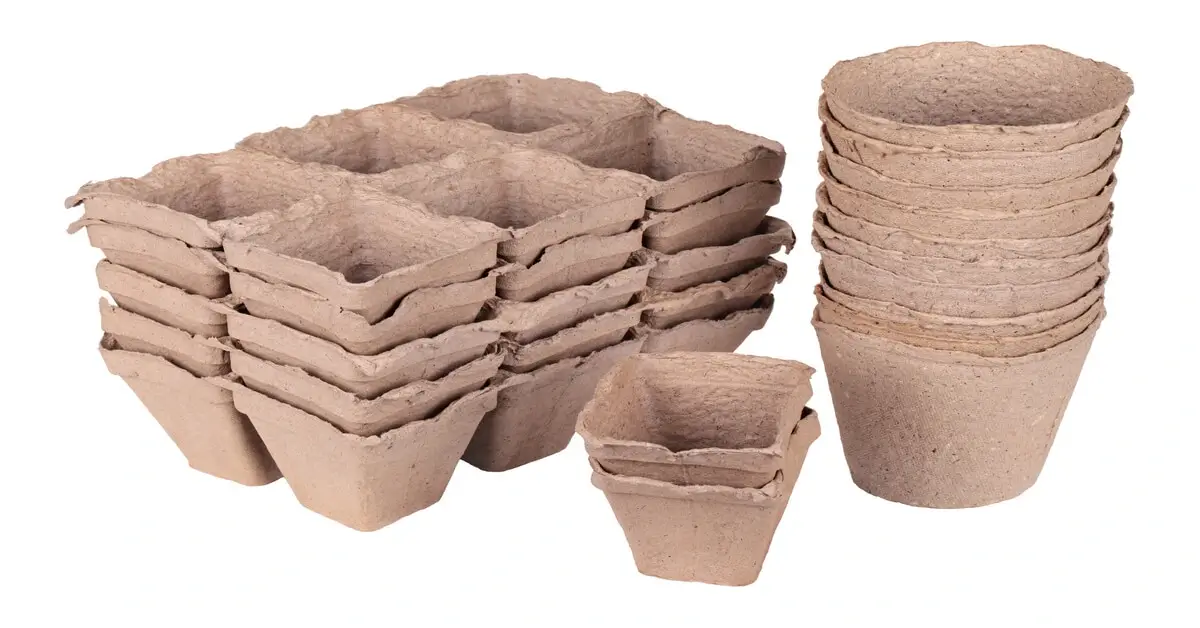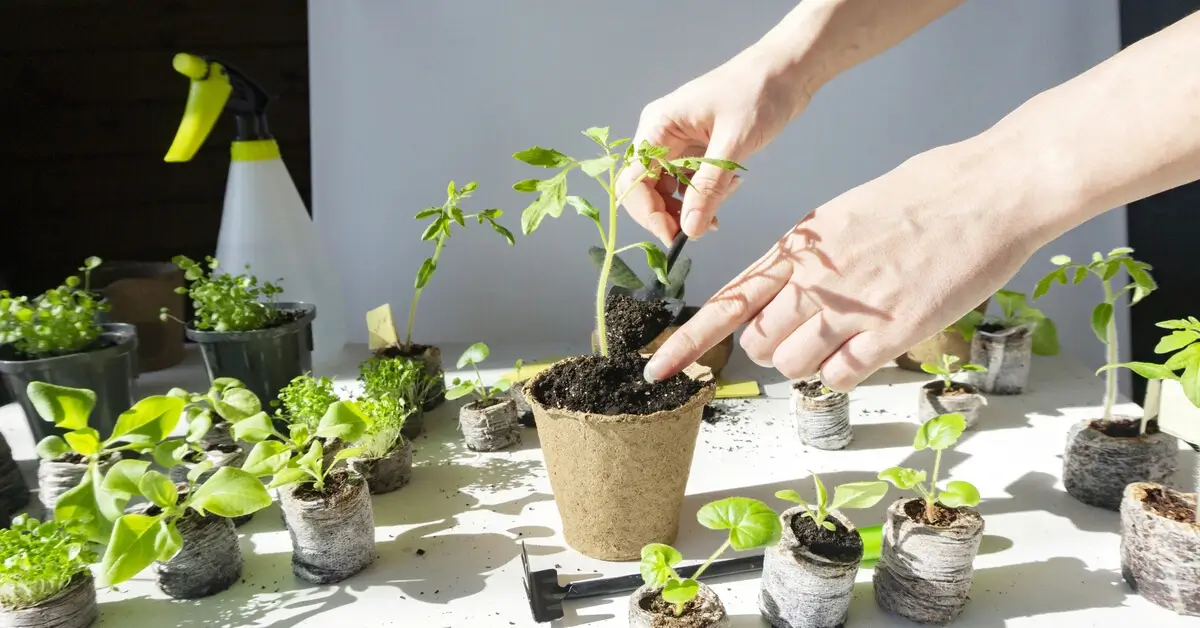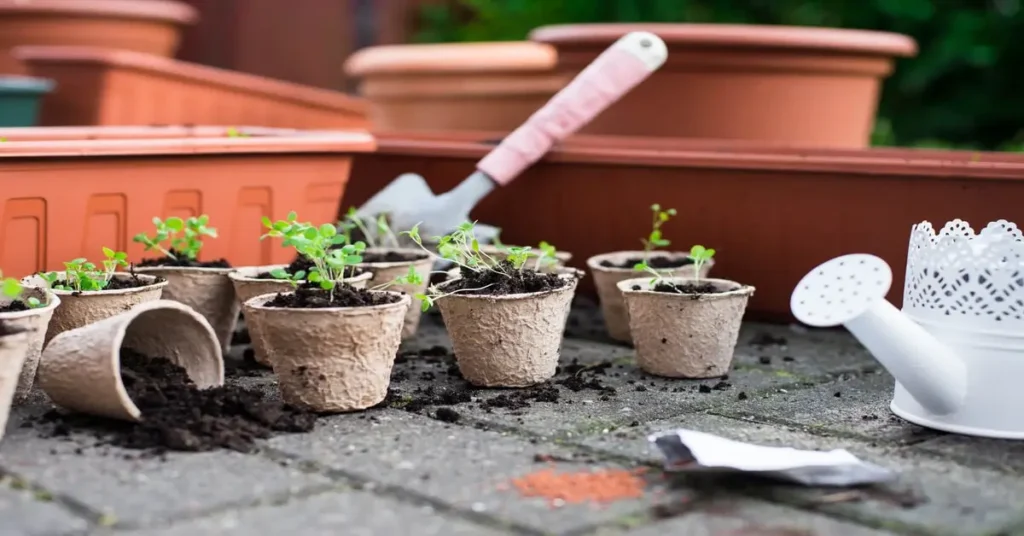The debate around the best way to start seeds is ever-evolving in gardening. Enter peat pots, a biodegradable alternative to plastic pots, capturing the attention of garden enthusiasts everywhere. Made primarily of peat moss and wood, these pots promise an eco-friendly start for your seedlings and a seamless transition into the garden. But the burning question remains: can these peat pots be planted directly in the ground? As we dive into peat pots, from their composition to their benefits, we’ll uncover the truth behind this gardening innovation.
The Basics of Peat Pots

The allure of gardening often lies in its blend of tradition and innovation. Peat pots, a relatively modern entrant in the gardening world, have quickly become a favorite among those looking for sustainable planting solutions. But what sets these pots apart? Let’s delve into peat pots’ essence, composition, and how they compare to other planting options.
What Exactly is a Peat Pot?
A peat pot is a biodegradable pot designed primarily for starting seeds before transplanting them into a larger pot or directly into the ground. Unlike plastic pot alternatives, peat pots are made of organic materials, predominantly peat moss, and sometimes combined with wood fibers. Their biodegradable nature means that they enrich the soil around the plant as it decomposes, providing an added nutrient boost.
The Materials and Process: How Are Peat Pots Made?
The primary ingredient in peat pots is peat moss, often sourced from Canadian sphagnum peat moss. This peat material is combined with wood fibers to create a peat slurry. This mixture is then molded into the desired pot shape, whether round peat pots or strips. Once shaped, the pots are dried, allowing them to hold their form. The result is a pot sturdy enough for starting seeds. Still, it will eventually break down in the soil, making peat pots a great alternative to plastic pots.
Differentiating Between Peat Pots, Peat Pellets, and Traditional Pots
While peat pots have gained popularity, other peat-based planting solutions are available. Peat pellets are small, compact discs that expand when saturated in water, offering a convenient way to start seeds. Like peat pots, these pellets are biodegradable and made with peat moss.
On the other hand, traditional pots, often made of plastic or clay, don’t decompose and require the plant to be removed before transplanting. Peat pots and pellets offer the advantage of being placed directly into the ground, reducing transplant shock and providing an eco-friendly planting solution.
Advantages of Using Peat in Gardening
Incorporating peat pots into gardening practices has become a game-changer for many enthusiasts. These biodegradable pots, made of peat moss and often combined with wood fibers, offer a sustainable and effective way to start seeds and transplant seedlings. But what makes them stand out in the vast world of gardening tools?
The Environmental Benefits of Using Peat Pots and Jiffy Peat Pellets
Transitioning from traditional plastic pot methods to peat pots and jiffy peat pellets is a step towards eco-friendly gardening. These pots are biodegradable, decomposing over time to become part of the soil. This decomposition process reduces the environmental burden of plastic waste. It enriches the garden as the pots release nutrients into the soil.
Moreover, peat pots are made of natural materials, ensuring that when they’re planted in the ground, they contribute positively to the environment.
How Peat Pots Promote Healthier Seedling Growth
Starting seeds in peat pots offers a nurturing environment for young plants. The peat material helps keep moisture around the roots, ensuring seedlings remain hydrated. As roots grow, they can penetrate the peat pot’s walls, allowing for natural growth and preventing root binding, a common issue in plastic pots.
When it’s time to transplant, the entire peat pot can be placed directly into the ground, offering a seamless transition for the seedlings and reducing transplant shock.
The Convenience of Using Peat Pots in the Garden
For those who want to grow plants without the hassle of repotting, peat pots provide a convenient solution. There’s no need to remove the plant from the pot before transplanting. Place the peat pot in the ground, which will decompose over time. This saves time and ensures that the seedlings experience minimal disturbance, especially for plants that don’t handle root disruptions well.
Additionally, peat pots also help maintain consistent moisture levels, ensuring the plants have a smooth transition from pot to garden.
Starting and Transplanting Seedlings in Peat Pots

Peat pots have revolutionized the early stages of gardening, offering a nurturing environment for seeds and simplifying the transplanting process. But how does one use these pots, and what are the benefits when moving the plants to their permanent homes?
The Process of Starting Seeds in Peat Pots
Starting seeds in peat pots is a great way to give your plants a head start. First, fill the peat pots with a suitable potting mix. Make an indentation in the planting side and sow your seeds according to their specific depth requirements.
Ensure the pots constantly remain moist but not soggy. As the seeds germinate, the warmth of the peat provides an ideal environment for young roots to grow. The porous nature of peat pots also ensures adequate air circulation, promoting healthier root development.
Once the seedlings have developed a few true leaves and are strong enough, they’re ready for the next step: transplanting.
Transplanting the Peat: Can You Plant the Entire Pot in the Ground?
One of the standout features of peat pots is the ease of transplanting. When your seedlings are ready to move to a larger pot or a garden bed, there’s no need for the tedious task of removing them from their containers. The entire peat pot can be placed directly into the ground.
Over time, the pot will decompose, allowing the growing roots to penetrate deeper into the soil. This method reduces transplant shock, ensuring plants not handling root disturbances well can settle into their new environment with minimal stress.
How Biodegradable Pots, Like Peat Pots, Benefit Both the Environment and Plant Roots
Biodegradable pots, especially those made of peat, offer dual benefits. Environmentally, they reduce the reliance on plastic pots, which can take hundreds of years to break down.
As peat pots decompose, they enrich the soil, releasing nutrients that plants can absorb. This decomposition feeds the plants and improves soil structure, promoting better water retention and aeration.
The decomposing pots provide a barrier-free space to grow the plant roots, ensuring they spread naturally without becoming root-bound. The result? Healthier plants are more resilient and better equipped to absorb nutrients from the surrounding soil.
Making, Buying, and Availability of Peat Pots
The demand for sustainable solutions like peat pots has surged as the gardening community becomes more environmentally conscious. Whether you’re looking to purchase them or craft your own, understanding the availability and appeal of peat pots is essential.
Exploring Where to Buy Peat Pots and the Varieties Available
For those eager to integrate peat pots into their gardening routine, numerous outlets offer a range of options. Local gardening centers often stock standard peat pots. At the same time, online platforms provide a broader selection, from round peat pots to peat strips.
When shopping, it’s essential to consider the size and type of pots suitable for your gardening needs. Some peat pots are also combined with other biodegradable materials, offering variations in decomposition rates and durability.
With the increasing demand, manufacturers of these pots have expanded their range, ensuring gardeners can find the perfect fit for their plants.
DIY Enthusiasts: How to Make Your Peat Pots at Home
Making your peat pots can be a rewarding experience for the hands-on gardener. Start by creating a peat slurry using sphagnum peat moss and water. Once you have a thick, moldable consistency, shape the mixture into pots or strips using molds or your hands. Allow them to dry thoroughly in a warm, airy location.
This DIY method offers customization in terms of pot size and shape and ensures that the pots are made with pure peat, free from additives. Crafting your pots can be cost-effective in the long run, especially if you want to grow many plants.
The Rise in Popularity: Why Are More Gardeners Choosing Peat Pots?
The shift towards sustainable gardening practices has propelled the popularity of peat pots. Gardeners are becoming more aware of the environmental impact of their choices, and peat pots offer an eco-friendly alternative to plastic pots. Their biodegradable nature means less waste in landfills and a reduced carbon footprint.
Additionally, the ease of transplanting the entire peat pot into the ground and its benefits to plant roots make them an attractive choice. As more gardeners share their positive experiences with peat pots, their reputation as a go-to planting solution grows.
Peat Pots vs. Traditional Pots: A Comparison
Choosing the right pot can significantly influence a plant’s growth and overall health in the diverse gardening world. As peat pots gain traction, many gardeners weigh their benefits against traditional pots. Let’s delve into a comparative analysis to determine which pot reigns supreme in various scenarios.
Weighing the Pros and Cons of Peat Pots Against Traditional Gardening Pots
At first glance, peat pots and traditional pots might seem to serve the same purpose, but a closer look reveals distinct differences:
Pros of Peat Pots:
- Biodegradability: Peat pots decompose over time, reducing waste and enriching the soil.
- Ease of Transplanting: Planting in peat pots eliminates the need to remove the plant for transplantation. The entire pot can be placed directly into the ground.
- Root Health: The porous nature of peat pots allows roots to breathe and grow without restriction.
Cons of Peat Pots:
- Durability: Unlike traditional pots, peat pots can degrade if left too long in a wet environment.
- Water Management: Peat pots can retain moisture, which is beneficial, but overwatering can cause them to become too soggy.
Pros of Traditional Pots:
- Reusability: Plastic or clay pots can be used multiple times, making them cost-effective in the long run.
- Sturdiness: They offer a stable environment, especially for larger plants.
Cons of Traditional Pots:
- Environmental Concerns: Plastic pots contribute to environmental waste.
- Transplanting Challenges: Removing plants for transplantation can cause root disturbances.
Situations Where One Might Be Preferable Over the Other
While both pot types have their merits, certain situations might make one more suitable than the other:
- Starting Seeds: Peat pots, especially jiffy pots, are ideal for germinating seeds. Their biodegradable nature and ability to retain moisture provide seedlings with a nurturing start.
- Long-Term Planting: For plants that will remain in pots for extended periods, traditional pots might be more suitable due to their durability. Additionally, holes in the bottom of conventional pots ensure proper drainage, preventing waterlogging.
- Eco-Conscious Gardening: Peat pots are a clear choice for gardeners prioritizing sustainability. Their biodegradable nature aligns with eco-friendly practices.
- Transplanting Sensitive Plants: Some plants don’t handle root disturbances well. In such cases, peat pots, which can be planted directly into the ground, are preferable.
Conclusion
In our exploration of peat pots, it’s clear that these biodegradable containers represent more than just a gardening tool; they symbolize a shift towards sustainability and environmental responsibility. As these pots naturally decompose, they enrich the soil, offering a stark contrast to the lasting ecological footprint of plastic pots.
For gardeners, using peat pots is about plant health and championing a greener future. By embracing such sustainable solutions, we nurture our plants and contribute positively to the broader environment, paving the way for a more eco-conscious future in gardening.

